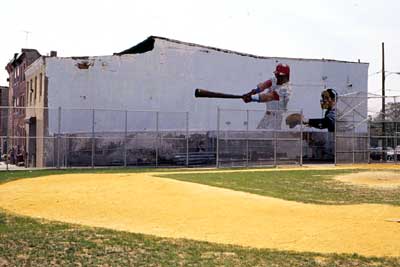Well, I do think the Mural Arts Program can be tagged with the non-controversial label. After all, we are talking about art that is planned with input from the community.
Yet a surprising number of the murals rise above the social-work approach. I think quantity and government support help. Just think about how theater flourished in ancient Greece, thanks to government support. And thanks to great playwrights.

But what interests me is how the murals succeed, where other public art projects have failed, in creating a heroic image of ordinary people.This is not an age of beyond-human greatness appropriate for Founding Fathers and saints. Our era is far more likely to buy into abstract, mandala-like trance art projecting a non-denominational or maybe vaguely Eastern spirituality (think Agnes Martin, here, or Bruce Pollock) than it is likely to buy into Saint Sebastian ecstatic with arrow piercings.
Public art that tries to reconcile greatness with our warts-and-all culture often fails. An example of that failure is the statue of former Philadelphia Mayor Frank Rizzo. Sculptor Zenos Frudakis aimed at the human level by siting Rizzo on steps used by the public. At the same time he aimed at heroism by making Rizzo larger than life. Yet the end product fails as a hero and fails as a commoner. Similarly, the figurative Vietnam sculpture [above], seems less than heroic and mostly just politically correct with its multiracial trio.
 The figures in the good murals, however, succeed in making just folks into heroes (see above right Peter Pagast’s “Ballfield,” 4th and Dauphin) and making public figures into inspirations.
The figures in the good murals, however, succeed in making just folks into heroes (see above right Peter Pagast’s “Ballfield,” 4th and Dauphin) and making public figures into inspirations.
And the landscapes that work best bring a whacky, personal vision of nature to the concrete jungle. They override their consensual origins with originality.









